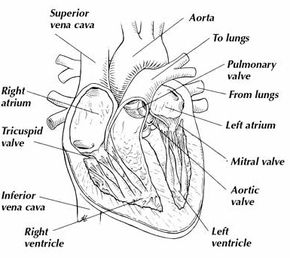The human heart holds a special place among bodily organs, a romanticized symbol of love, courage and compassion. But its functions in the body are as practical as they are necessary. Located in the center of the chest (but tipped to the left), this pump sends blood circulating throughout our body, ensuring that oxygen and nutrients are brought to organs and tissues and that harmful wastes are carried away.
Your heart may be only slightly larger than your fist but it's one tough muscle. The average heart expands and contracts about 100,000 times each day, pumping about 2,000 gallons of blood throughout the body.
Advertisement
Pump it Up The heart is a muscular pump with four chambers. The two upper ones are called atria and the two thicker, lower ones are called ventricles. The left atrium and ventricle are separated from the right atrium and ventricle by a muscular wall known as the septum.
Your heart also has four valves, located at the exit of each chamber. When a chamber contracts, the valve at its exit opens so that blood can flow through. At the end of the contraction, the valve closes so that blood doesn't flow backwards.
Several large blood vessels connect to the heart:
- The aorta carries oxygenated blood to the entire body from the left ventricle.
- The pulmonary artery leaves the right ventricle and branches to carry deoxygenated blood to the lungs.
- The pulmonary veins carry newly oxygenated blood back from the lungs to the left atrium.
- The superior vena cava carries used blood from the head and arms into the right atrium.
- The inferior vena cava brings used blood from the legs, pelvis and abdomen into the right atrium.
Your Beating Heart
Used, deoxygenated blood from your body enters the heart's right atrium. The right atrium contracts, pumping blood into the right ventricle. When that in turn contracts, the blood is sent to the lungs via the pulmonary arteries. There, it's reoxygenated and returned to the left atrium via the pulmonary veins. The left atrium contracts, sending the blood into the left ventricle, which then pumps it to the rest of the body via the aorta.
Keeping Pace How does your body maintain all that pumping on a regular basis? The body has a natural pacemaker located in the sinoatrial node, which is located in the right atrium. It generates electrical impulses, which cause the atria to contract. Once the ventricles have filled up with blood, the electrical impulses also cause them to contract simultaneously.
For more information about the heart and keeping it healthy, see the links on the next page.
Advertisement
